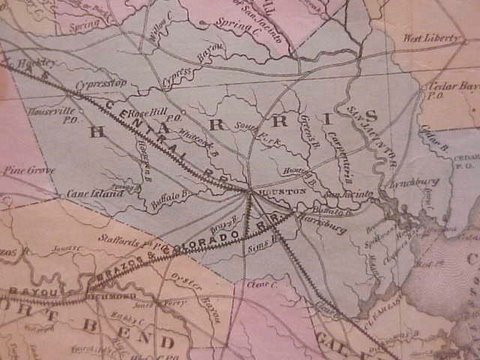
Stafford, Texas
STAFFORD, TEXAS-POSTMASTERS
(Re-established) Lavery, Carl C., 11 Apr 1929
STAFFORDSVILLE, TEXAS-POSTMASTERS
Cg'd to STAFFORD, 26 Feb 1869
Stafford Point
Marker located 3 blocks southof A90 (in front of public library) [1977]
|
One of Stephen F. Austin's "Old 300," William J. Stafford (1764-1840), founded the settlement of Stafford's Point on the 6819.7-acre land grant he received in the winter of 1824. Bringing his family and slaves from his Louisiana sugar plantation, he was planting much land and had a sugar mill and cotton gin in operation by 1834. His manager, Clement c. Dyer (1800-64), a lawyer, political leader, and (later) county judge, married Stafford's daughter, Sarah (1809-74). Early residents of the Stafford's Point community included families of Sam Bell, Elijah Roark, Dr. P. W. Rose, Moses Shipman, and Mr. West. Dr. Rose, a former U. S. Army surgeon, tended the sick and also hired (1834) a teacher for his children and ten others studying in a one-room schoolhouse. In the "Runaway Scrape" of 1836, the settlers and their slaves fled east as Santa Anna's Army camped here, pillaging homes and mills. Stafford's Point was resettled after the War for Independence, and again prospered. The buffalo Bayou, Brazos & Colorado, first railroad in Texas, was completed from Harrisburg to this village in 1853. From 1915 to 1925, a number of Sicilian families moved here from brazos County. Stafford's Point was incorporated into the town of Stafford in 1956. Read more Andrew Jackson Roark Leo Roark |
STAFFORD'S POINT, TEXAS-POSTMASTERS
Stafford Plantation
Sugar Land, Off 500 block of Dulles Avenue. [2003]
Tennessean William Joseph Stafford and his second wife, Martha Cartwright, moved their family to this area in 1822 as part of Stephen F. Austin's "Old 300" colony. Here they reared eight children and developed a plantation with a sugar cane mill and cotton gin. The plantation, known as Stafford's Point, produced sugar with a high molasses content and prospered even when local cotton production was low. During the Texas Revolution, Mexican troops burned the plantation buildings, but the family rebuilt, and the settlement surrounding the plantation became a commercial center, known today as Stafford. This site is thought to be the cemetery of the early Stafford Plantation. Read more Clement C. Dyer
Stafford Family Cemetery [1962]
Paschal Paolo Borden
Star and Wreath Born in New York, 1806; came to Texas, December 17, 1829 as a soldier in the Texas War for Independence. He participated in the campaign to capture Bexar, 1835, and fought in the Battle of San Jacinto April 21, 1836. Died April 28, 1864. Read more
Buffalo Bayou, Brazos & Colorado, First Railroad in Texas
Marker located on 90-A or S. Main [1967]
Planned 1840 to benefit the Republic of Texas by moving rich sugar and cotton crops from plantation areas. Chartered 1841 by 5th Congress of the Republic, in name of Harrisburg Railroad & Trading Company. H. R. & T. C. did not succeed in building a railroad. Its holdings were transferred in 1847 to Gen. Sidney Sherman, a hero of the Battle of San Jacinto, who was backed by eastern capital and leading texans -- W. J. Hutchins, gen. Hugh McLeod, Wm. Marsh Rice (benefactor of Rice University), B. A. Shepherd, James H. Stevens, and John Grant Tod (a former Texas naval officer). B. F. Terry (destined to lead Terry's Texas Rangers in the Civil War) and W. J. Kyle graded the roadbed. The first locomotive, "General Sherman," arrived 1852. In August 1853 the tracks extended 20 miles from Harrisburg to Stafford's Point, early Texas center of trade and social life. On Sept. 1, with fanfare, a special train brought a load of honored guests to join planters here for a barbecue-jubilee. Regular schedules were soon in operation. Stafford's Point, end of the line for two years, did much business. Buffalo Bayou, Brazos & Colorado in 1860 reached Alleyton -- a distance of 80 miles from Harrisburg. Incise in base: Early Travel, Transportation and Communication Series erected by the Moody Foundation. Read more